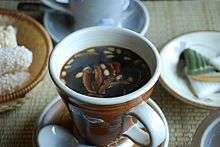Ssanghwa-tang
Ssanghwa-tang with an egg yolk | ||||
| Type | Traditional Korean tea | |||
|---|---|---|---|---|
| Country of origin | Korea | |||
| Colour | Deep brown | |||
| Flavour | Slightly bitter | |||
| Ingredients | White woodland peony root, Rehmannia root, Mongolian milkvetch root, Korean angelica root, lovage root, Chinese cinnamon bark, Chinese liquorice | |||
| Korean name | |
| Hangul | 쌍화탕 |
|---|---|
| Hanja | 雙和湯 |
| Revised Romanization | ssanghwa-tang |
| McCune–Reischauer | ssanghwa-t'ang |
| IPA | [s͈aŋ.ɦwa.tʰaŋ] |
| Hangul | 쌍화차 |
| Hanja | 雙和茶 |
| Revised Romanization | ssanghwa-cha |
| McCune–Reischauer | ssanghwa-ch'a |
| IPA | [s͈aŋ.ɦwa.tɕʰa] |
Ssanghwa-tang (쌍화탕; 雙和湯) or ssanghwa-cha (쌍화차; 雙和茶) is a traditional Korean tea with deep brown colour and a slightly bitter taste. Along with sipjeondaebotang, it is one of the most popular types of medical tea in Korea.[1]
It is made by boiling down a number of medical herbs such as dried roots of white woodland peony (백작약; 白芍藥; baekjagyak), steamed and dried roots of rehmannia (숙지황; 熟地黃; sukjihwang), dried roots of Mongolian milkvetch (황기; 黃芪; hwanggi), dried roots of Korean angelica (당귀; 當歸; danggwi), dried roots of lovage (천궁; 川芎; cheongung), Chinese cinnamon barks (계피; 桂皮; gyepi), and Chinese liquorice (감초; 甘草; gamcho). However, many people today buy the tea pre-made.[2]
See also
References
- ↑ "The Health Benefits of Traditional Korean Tea". The Chosun Ilbo. 21 February 2015. Retrieved 2 February 2017.
- ↑ "The World of Korean Tea – Medicinal Tea". Korea Tourism Organization. Retrieved 2 February 2017.
This article is issued from
Wikipedia.
The text is licensed under Creative Commons - Attribution - Sharealike.
Additional terms may apply for the media files.

